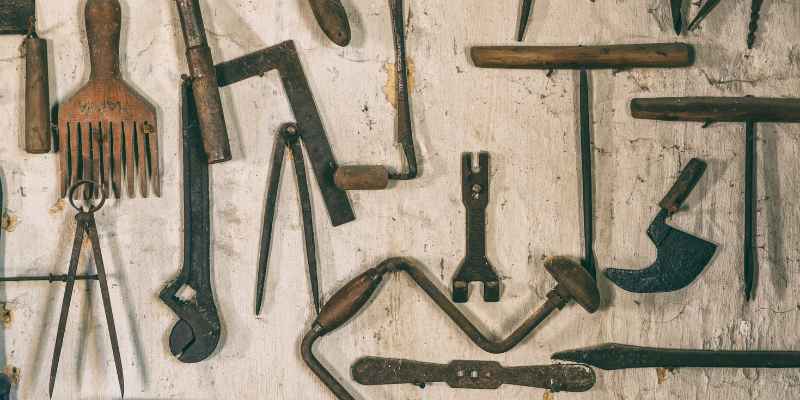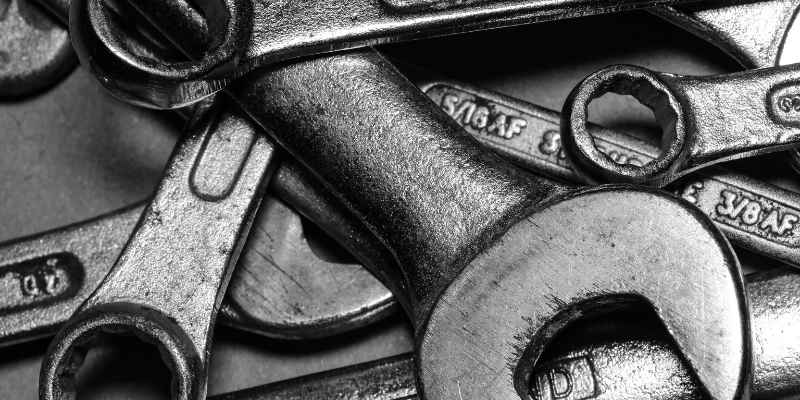To remove rust from metal tools, soak them in vinegar or lemon juice for a few hours, then scrub with a wire brush. Rust can be a common problem for metal tools, causing them to become dull and less effective over time.
However, with the right techniques, you can easily remove rust and restore their functionality. This article will guide you on how to remove rust from metal tools using simple and effective methods. Whether you have rusty pliers, screwdrivers, or hammers, we have got you covered.
By following these steps, you can eliminate rust, prevent further damage, and prolong the lifespan of your tools. So, let’s dig into the details and get your tools back in tip-top shape.

Prevention Methods
Preventing rust on metal tools is key to ensuring their longevity and performance. By implementing the right prevention methods, you can safeguard your tools against corrosion and maintain their functionality.
Proper Storage
Avoid leaving metal tools exposed to moisture and humidity. Keep them in a dry environment and store them in a cool, well-ventilated area to prevent rust formation.
Use Of Rust Inhibitors
Applying a protective coating or rust inhibitor on metal tools can act as a barrier against moisture and oxidation, effectively preventing rust from developing.
Traditional Removal Techniques
Traditional removal techniques are a tried and tested method for removing rust from metal tools. These techniques are often inexpensive and use common household items. If you have rusty metal tools lying around, why not give these methods a try? In this article, we will explore two traditional removal techniques: Vinegar Soak and Baking Soda Paste.
Vinegar Soak
Vinegar, a pantry staple in many homes, can be used to remove rust from metal tools effectively. Its high acidity helps dissolve the rust, making it easier to scrub away. Here’s how to use vinegar to remove rust:
- Prepare a mixture of equal parts white vinegar and water.
- Submerge the rusty tools in the vinegar solution, ensuring they are completely covered.
- Allow the tools to soak for at least 24 hours. For heavily rusted tools, you may need to extend the soaking time.
- After the soaking period, remove the tools from the solution and scrub away the loosened rust using a scrub brush or steel wool.
- Rinse the tools thoroughly with water to remove any vinegar residue.
- Dry the tools completely to prevent new rust from forming.
Vinegar is a versatile solution, and it can be used for various other cleaning tasks around the house.
Baking Soda Paste
Baking soda, another common ingredient in most kitchens, can also be used to remove rust from metal tools. Its mild abrasive properties and alkaline nature help break down rust without damaging the metal’s surface. Follow these steps to create and use a baking soda paste:
- In a small bowl, mix baking soda with a few drops of water to form a thick paste.
- Apply the paste directly onto the rusted areas of the metal tools.
- Let the paste sit on the tools for about an hour to allow it to penetrate the rust.
- Using a scrub brush or steel wool, gently scrub the rusted areas in a circular motion.
- Rinse the tools thoroughly to remove any remaining paste.
- Dry the tools completely to prevent further rusting.
Baking soda is not only effective for rust removal but also helps eliminate odors and acts as a natural cleaning agent in various other applications.
Chemical Rust Removal
Rust can be stubborn and difficult to remove, especially on metal tools that have been neglected or exposed to moisture. Chemical rust removal methods can be particularly effective in restoring rusty metal tools to their former glory.
Commercial Rust Removers
Commercial rust removers are readily available and are formulated to efficiently dissolve rust without damaging the underlying metal. These products can be found in various forms, including liquids, gels, or aerosol sprays, offering a convenient solution for removing rust from metal tools.
Phosphoric Acid Solutions
Phosphoric acid solutions are highly effective in removing rust from metal surfaces. The acid reacts with the iron oxide present in rust, converting it into a more stable compound and making it easier to scrub away. When using phosphoric acid solutions, it is vital to follow safety precautions and wear protective gear to avoid any potential hazards.
Mechanical Methods
Mechanical methods are effective in removing rust from metal tools. These processes involve the use of physical force or abrasion to get rid of the rust. Some of the common mechanical methods include wire brushing and sandblasting.
Wire Brushing
Wire brushing is a simple and inexpensive method for rust removal. It involves using a wire brush to scrub the rusted surface vigorously until the rust is completely removed. This method is ideal for small tools and areas that are difficult to reach. Care should be taken to ensure that the surrounding area is protected from flying rust particles during the brushing process.
Sandblasting
Sandblasting is a more aggressive method that utilizes compressed air to propel fine sand or other abrasive materials at high speed onto the rusted surface. The abrasives effectively remove the rust, leaving a clean surface. However, sandblasting requires specialized equipment and should be performed in a controlled environment to prevent damage to the metal surface and ensure safety.
Electrolysis
To remove rust from metal tools, electrolysis is a highly effective method. By using a power source, water, and a chemical solution, electrolysis removes rust from metal surfaces. This process breaks down the rust and leaves the metal tools clean and rust-free.
Diy Electrolysis Setup
Electrolysis is a simple yet highly effective method for removing rust from metal tools. With a basic DIY setup, you can tackle stubborn rust and restore your favorite tools to their former glory. Here’s how you can set up your own electrolysis tank to remove rust from metal tools:
- Gather the necessary materials:
- A plastic container large enough to hold your tools.
- A sacrificial anode (such as a piece of scrap steel or iron).
- A battery charger or power supply.
- Washing soda or baking soda.
- Alligator clips or wire connectors.
- Distilled water.
- Prepare the setup:
Fill the plastic container with enough distilled water to fully submerge your rusty tools. Dissolve washing soda or baking soda in the water until it reaches a concentration of about one tablespoon per gallon. Position the sacrificial anode in the container, making sure it does not touch the tools. Connect the negative terminal of the battery charger to the anode and the positive terminal to the rusty tool with alligator clips or wire connectors.
- Turn on the power:
Once everything is set up, turn on the battery charger or power supply. You should observe small bubbles forming on the surface of the rusty tool and rising from the anode. This indicates that electrolysis is taking place and the rust is being removed.
Benefits Of Electrolysis
Electrolysis offers several benefits over traditional rust removal methods:
- Effective rust removal: Electrolysis can remove rust from even the most heavily corroded tools, restoring them to their original condition.
- Gentle on metals: Unlike abrasive methods, electrolysis does not damage the underlying metal surface, making it ideal for delicate or valuable tools.
- Environmentally friendly: Electrolysis eliminates the need for hazardous chemicals typically used in rust removal, reducing harm to the environment.
- Budget-friendly: With DIY electrolysis, you don’t have to spend a fortune on commercial rust removal products. Most of the required materials can be easily obtained at a low cost.
- Time-efficient: Depending on the severity of the rust, electrolysis can remove it in a matter of hours or days, allowing you to quickly get back to working with your tools.
By following these simple steps and understanding the benefits of electrolysis, you can confidently remove rust from your metal tools. Give this method a try and witness the transformative power of this DIY rust removal technique!
Natural Rust Removal
Rust can be a pesky problem on metal tools, but there are natural methods you can use to effectively remove it without harsh chemicals. Natural rust removal techniques are not only environmentally friendly but also safe for your tools. Let’s explore some of these methods below:
Lemon And Salt
Lemons are acidic and can help dissolve rust, while salt acts as an abrasive to scrub it off.
- Cut a lemon in half and sprinkle salt on the rusted areas.
- Rub the lemon over the rusted spots, squeezing the juice as you go.
- Let it sit for a few hours, then scrub with a brush or steel wool.
Potato And Dish Soap
A potato contains oxalic acid, which can aid in rust removal, and dish soap helps to lift away the rust.
- Cut a potato in half and dip it in dish soap.
- Rub the potato over the rusted areas, ensuring they are well coated.
- Leave it for a few hours and scrub with a brush to remove the rust.
Final Thoughts
To remove rust from metal tools, try using vinegar or lemon juice to break down the rust. Scrub the affected areas with a wire brush or steel wool, then rinse and dry thoroughly to prevent further rusting.
Choosing The Right Method
Before tackling rust on metal tools, identify the extent and severity of the rust to choose the most effective method.
Depending on the tool material and the depth of the rust, you may opt for chemical treatments, mechanical methods, or a combination of both.
Consult with experts or follow manufacturer guidelines for specific tool types to ensure safe and efficient removal.
Maintenance Tips
Regularly clean and dry metal tools after use to prevent rust from forming in the first place.
Apply protective coatings such as oil or wax to create a barrier against moisture and air exposure.
Store tools in a dry environment and invest in rust inhibitors to extend their lifespan.

Frequently Asked Questions For How Do You Remove Rust From Metal Tools
Can Vinegar Remove Rust From Metal Tools?
Yes, vinegar can effectively remove rust from metal tools. Soak the tools in vinegar for a few hours, then scrub with a brush or steel wool.
Is Baking Soda Effective For Rust Removal?
Absolutely! Baking soda mixed with water creates a paste that can be applied to rusted areas. Let it sit for a few hours before scrubbing and rinsing.
How Does Electrolysis Remove Rust From Metal Tools?
Electrolysis uses a low-voltage electrical current and a solution to remove rust from metal tools. It’s a safe and effective method for restoring heavily rusted items.
Conclusion
To efficiently remove rust from metal tools, it is important to follow the right techniques and utilize the appropriate tools. By adopting methods such as using vinegar or lemon juice, scrubbing with a wire brush, and applying rust converters or inhibitors, you can effectively restore your tools to their former glory.
Regular maintenance and storage practices can also prevent rust formation in the future, prolonging the lifespan of your tools. Always remember to exercise caution and wear protective gear when handling chemicals. With these simple yet effective tips, you can say goodbye to rust and enjoy the durability of your metal tools for years to come.


